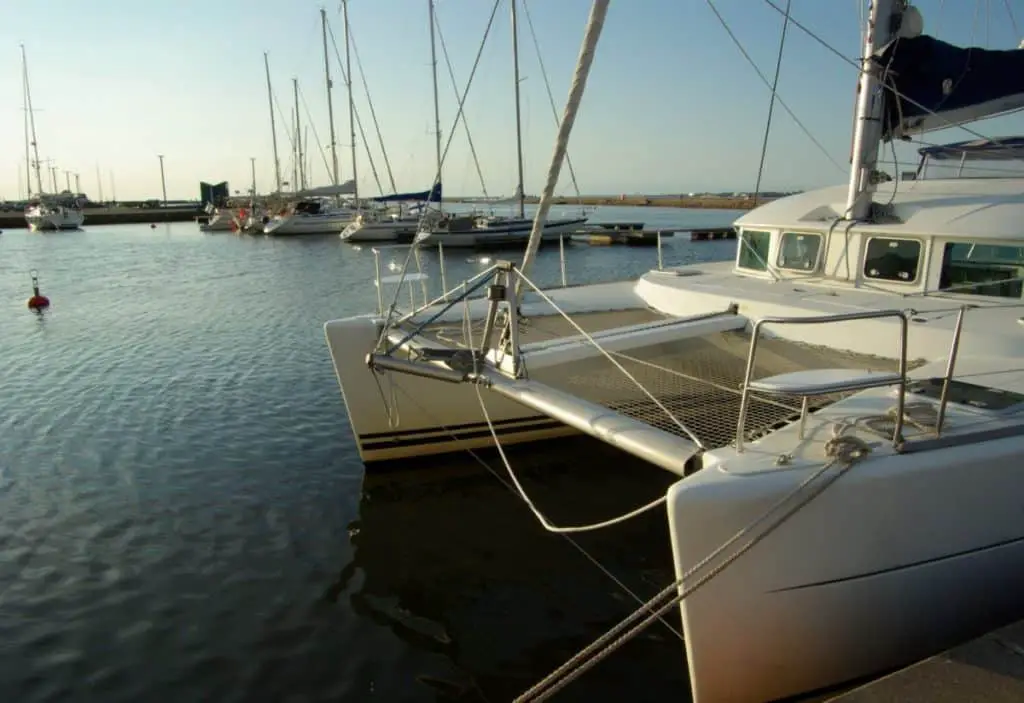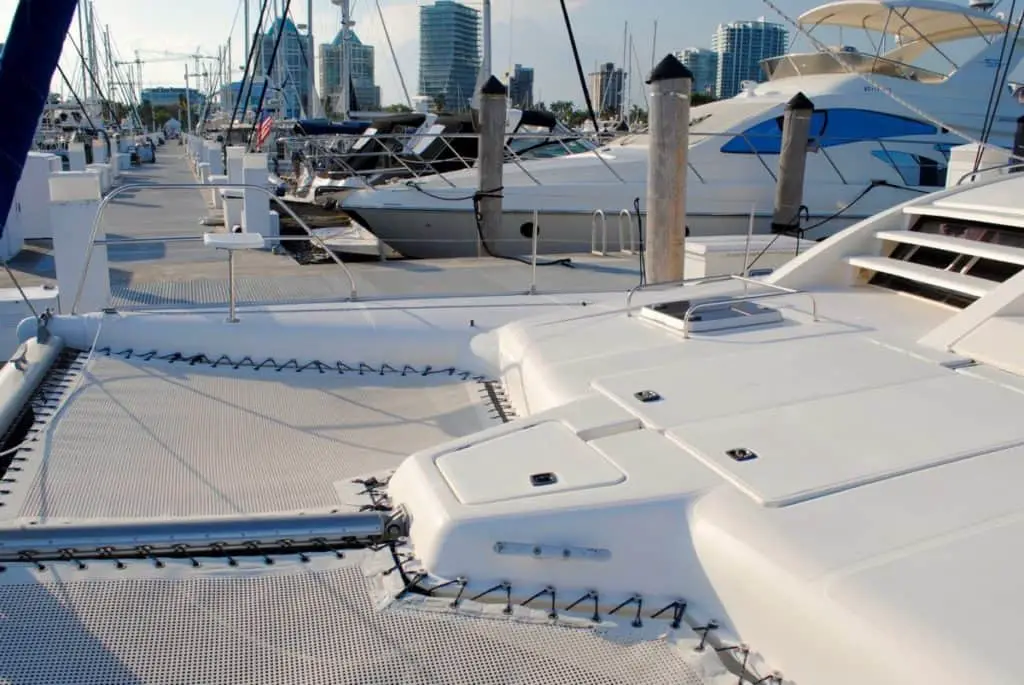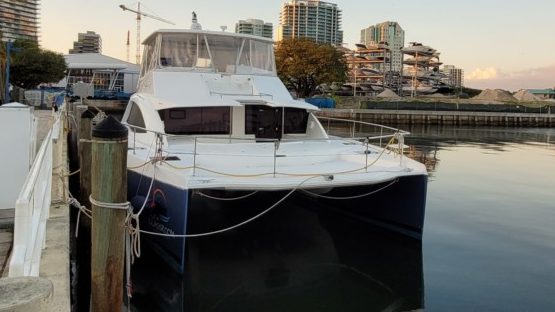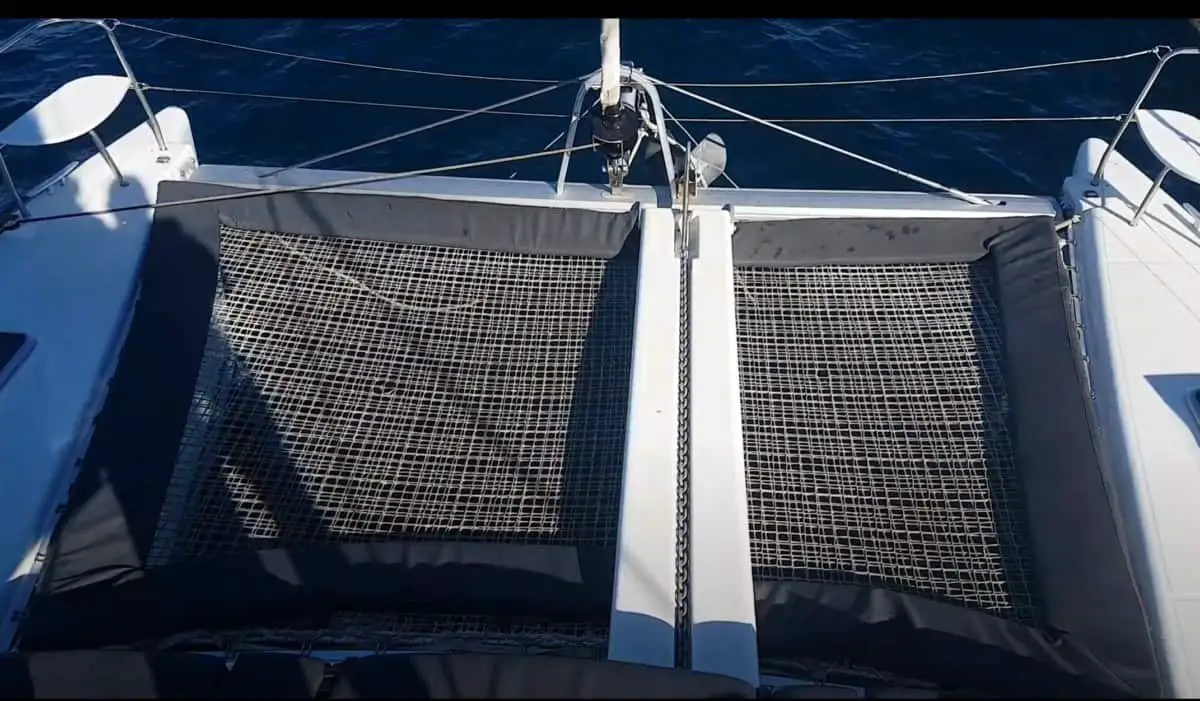As an Amazon Associate, we earn from qualifying purchases. We may also earn commissions if you purchase products from other retailers after clicking on a link from our site.
Just as you probably are right now, I wondered what that weird net in the front of the catamaran is and what it does, it looks fun, but surely that’s not why they put it there? During my research, I have come to discover that trampolines on catamarans are intricate and have a more significant impact on the boat than I first thought.
A trampoline on a catamaran is a squared net at the bow that reduces the risk of capsizing and increases handling and performance. It allows for water to quickly pass through and it reduces the weight forward of the mast. Trampolines can also be used as a place to sit and relax
Continue reading to understand why trampolines on a catamaran are important and how they work.
- Contrary to a solid deck, a trampoline allows water to pass through. This significantly reduces the amount of water that can weigh down on the bows In a situation where the bow gets buried in a wave.
- A trampoline reduces the structural weight forward of the mast, which moves the center of gravity towards the middle of the boat, limiting the pitching effect and reducing the likelihood of burying the bows.
Now that we know what a trampoline does; let’s dig a little deeper and see if we can figure out how it works and why it is important to keep your bows above water level.
The Benefits of Trampolines Over Solid Decking On a Catamaran

1. Trampolines Reduce The CONSEQUENCES of Burying The Bows
One big benefit of catamarans over monohulls is their speed, but this can also be their downfall if the cat is poorly designed.
When the conditions are right Catamarans are sometimes able to semi-surf down a wave and further increase its speed. When this happens, there is a possibility that the bows will crash into the next wave, and instead of the boat going up and over, it digs its bows straight into the wave.
International Journal of Small Craft Technology
If the boat can´t dissipate the water over the bows before the next wave from behind reaches the stern, the cat is at risk of flipping over, also known as capsizing (Source).
If the bows get buried, it’s of the highest importance to remove that downward force as soon as possible. With a solid deck, the water needs to pass over and around the boat, this takes time, and time is at a premium in a situation like this.

On the other hand, with a trampoline, the weight of the water has less area to press down on (there are holes in the net), instead, the water flows in between the two hulls, only slightly hindered by the mesh.
This means that the area where water can accumulate is much smaller, and also means that water now has a second route to dissipate, straight down. Thus shortening the time when the bows are under load and in danger of a big wave flipping the cat over.
The same principles apply when running your hand through the water, with your fingers spread out you move more easily in the water, and with the hand flat and fingers together, it’s much harder.
Now that we have understood the risks involved with burying the bows, let’s look at how the trampoline not only reduces the consequences but also reduces the likelihood (consequences * likelihood = risk).
2. Trampolines Reduce The LIKELIHOOD of Burying The Bows
We now know what could happen if we do bury the bows, reducing the likelihood should be one of our highest priorities if we want to have a safe time on the ocean.
The Problem
Personally, I think that Eric Smith of Atlantic-cruising.com does a great job explaining how catamarans are using physics to their advantage. One point he makes is the importance of the center of balance to reduce pitching (the motion of a seesaw).
Just as with a car, there is a need for a low and centered point of balance/gravity to minimize the risk of flipping over (or capsizing if in a boat). When designing a car, attaining a low center of gravity (COG) is fairly easy, on a catamaran, it’s a little bit more intricate.
On the one hand, you want to design a boat where the COG is close to the surface (or even below the surface in a monohull), this will reduce the pitching movement and create a more stable boat.

On the other hand, you want a high enough boat to let waves pass under the deck, this will reduce what is called bridge deck slamming.
Long-term bridge deck slamming will take its toll on both crew and vessel and is, therefore, a safety concern.
The Solution
Knowing all this, it makes sense to replace the hefty glass fiber deck with a lightweight mesh (aka trampolines), thus reducing the weight of the catamaran (which increases speed) but also moving the center of gravity towards the middle of the boat.
Another benefit of having a vessel that doesn’t pitch as much, is the decrease in seasickness prevalence.
Avoiding seasickness isn’t just nice, seasickness gets you tired, causing you to make bad decisions, and ultimately might be a safety issue.
If removing that water quickly is so important, why is there not just a big hole? Good question, I would argue that there are several reasons; one is that sailing the boat will require you to move all the way to the bow of the boat, and in this case, the trampoline acts as a floor, hindering you from having to balance around and possibly falling into the sea.
It is also worth mentioning that there are different nets to be used, some are more open webbed than others, and the more open the faster the drain of water will be.

Catamaran Trampoline as a Social Area
Technical and safety aspects aside the trampoline are one of the main social areas on a catamaran, it is a beautiful place to enjoy a sunset with some drinks, or do some dolphin watching while underway. This area becomes even more important on smaller boats when outside areas aft of the mast area are limited.
Risks aside, having a solid deck could really be a game-changer when it comes to the social aspects of a sail. If the boat isn’t used for crossing the Atlantic every Thursday, then it is definitely something that brings a lot of value to your trip. Sailing coastal, I would go with a solid deck, and for the great seas, I would choose trampolines.
Why Do New Bali Catamarans Have Solid Foredeck?
With the continuous development in technology, it is now possible to make a foredeck that is quite lightweight but still very strong compared to ten years ago. This has made it possible for manufacturers to bring back the solid foredeck without adding too much weight.
Considering that a solid foredeck adds buoyancy and protects the helm from spray, it can be argued that a lightweight foredeck such as on the Bali 5.4 is just as, or even safer than an older trampoline design.
Especially if the water drainage system is built correctly, which seems to be the case on Bali 5.4 (Source).
Conclusion
Trampolines have both a social and a safety function on a catamaran, reduced pitching, less risk of burying the bows, and a perfect place to watch the sunsets.
“Netting forward rather than solid decking is crucial for an offshore cat‐for comfort and for safety!“
Eric Smith of atlantic-cruising.com

